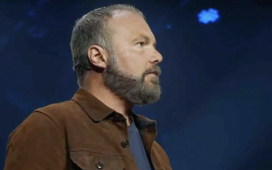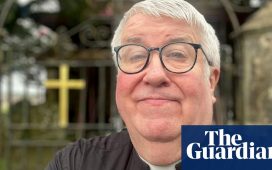When I was a baby, my grandfather delighted me by playing a game. He made a fist sandwich, fingers laced together and hidden in his palms, showing me his thumbs closed upon them. Slowly, he would say, “Here’s the church, and here’s the steeple,” raising his index fingers together to form a peak. Then, throwing his thumbs apart, he flipped his interlaced fingers over, wriggling them and crying out, “Open the doors and see all the people!”
My grandfather was a Christian Scientist. His mother had been a Scientist. His only child, my father, was a Scientist. I was raised to be a Scientist.
Now I’m delighted by a different kind of game: counting the churches as their doors close. In 20 years, drastic changes have taken place, but the most arresting is the church’s precipitous fall. It’s getting harder and harder to see all the people, because they’re disappearing.
The early popularity of Christian Science was tied directly to the promise engendered by its core beliefs: the promise of healing. The overwhelming majority of those attracted to the movement came to be healed, or came because a husband, wife, child, relative or friend needed healing; the claims of Christian Science were so compelling that people often stayed in the movement whether they found healing or not, blaming themselves and not the church’s teachings for any apparent failures.
The teachings were radically simple. The founder and leader of the church, Mary Baker Eddy, taught that disease was unreal because the human body and the entire material world were mere illusions of the credulous, a waking dream. Those who awoke and knew the “Truth” could be instantaneously healed. (Eddy was big on capitalised generalities; “Life”, “Love” and “Spirit” were among her other “synonyms” for God.)
What was the “Truth”? We memorised it in Sunday School, the “Scientific Statement of Being”, which assured us that “there is no life, truth, intelligence, nor substance in matter”. Eddy’s definition of man was even more stark: “Man is not matter; he is not made up of brain, blood, bones, and other material elements.” We were instructed to repeat as needed for whatever ailment came along, from canker sores to cancer. The trick lay in the application: allow no hint of doubt, neither aspirin nor vitamin, a dogma so dire it was taken to absurd lengths. During the height of the London fad for the faith, in 1911, novelist VS Pritchett was indoctrinated into the mysteries by his father after “dying Cousin Dick” leapt from his deathbed, “miraculously cured”. Soon after, Pritchett, a lad of 11, was forced to walk to school on a sprained ankle.
As Pritchett discovered, Cousin Dick’s results were impossible to replicate in the real world, and the consequences of Eddy’s strictures – she demanded “radical reliance” on her methodology to the exclusion of all else – quickly caused havoc. Newspapers and prosecutors noticed the casualties, especially children dying of unreported cases of diphtheria and appendicitis. In the early years of the church, this touched off battles with the American Medical Association, which tried to have Christian Science healers, or “practitioners”, arrested for practising medicine without a licence. Since practitioners did nothing but pray, however, their activities were protected by the US constitution. Reacting with righteous zeal, Church leaders doubled down for decades, furtively slipping protections into the law and encouraging insurance companies to cover Christian Science “treatment”. Since it cost very little, the companies cynically complied.
As a result, by the 1970s – a high-water mark for the church’s political power, with many Scientists serving in Richard Nixon’s White House and federal agencies – the church was well on its way to accumulating an incredible array of legal rights and privileges across the US, including broad-based religious exemptions from childhood immunisations in 47 states, as well as exemptions from routine screening tests and procedures given to newborns in hospitals. The exemptions had consequences: modern-day outbreaks of diphtheria, polio and measles in Christian Science schools and communities. A 1972 polio outbreak in Connecticut left multiple children partially paralysed; a 1985 measles outbreak (one of several) at Principia College in Illinois killed three.
In many US states, Scientists were exempt from charges of child abuse, neglect and endangerment, as well as from failure to report such crimes. Practitioners with no medical training (they become “listed” after two weeks of religious indoctrination) were recognised as health providers, and in some states were required to report contagious illnesses or cases of child abuse or neglect, even as their religion demanded that they deny the evidence of the physical senses. Practitioners, of course, have no way of recognising the symptoms of an illness, even if they believe it existed, which they don’t.
A whole system of Christian Science “nursing” sprang up in unlicensed Christian Science sanatoriums and nursing homes catering to patients with open wounds and bodies eaten away by tumours. There, no medical treatment was allowed to interfere with prayer. Assigned only the most basic duties – feeding and cleaning patients – Christian Science “nurses” are not registered, and have no medical training either. Instead, they engage in bizarre practices such as leaving food on the mouths of patients who cannot eat. They provide no assistance for those who are having trouble breathing, administer no painkillers, react to no emergencies. “Do not resuscitate” is their default. But some of these facilities, and the incompetent care they provide, are covered by Medicare, the US’s national healthcare insurance programme.
Still, by this point, few people know or care what the Christian Scientists have been up to, since the average person can’t tell you the difference between a Christian Scientist and a Scientologist. The decline of the faith, once a major indigenous sect, may be among the most dramatic contractions in the history of American religion. Eddy forbade counting the faithful, but in 1961, the year I was born, the number of branch churches worldwide reached a high of 3,273. By the mid-80s, the number in the US had dropped to 1,997; between 1987 and late 2018, 1,070 more closed, while only 83 opened, leaving around a thousand in the US.
Prized urban branches are being sold off by the score, converted into luxury condominiums, museums and Buddhist temples. The branch I attended, on Mercer Island, near Seattle, is now Congregation Shevet Achim, a Modern Orthodox synagogue.
Worldly erosion eats away at the remainder. New York’s Third Church on Park Avenue is still open for spiritual business, but is leased for events during the week, sparking complaints about blocked traffic, paparazzi and partygoers attending celebrity galas in the four-storey neo-Georgian sanctuary. The phrase “God is Love” is traditionally affixed to an interior wall of every branch, but during secular events the words are concealed behind a faux-slate panel, lest they detract from, say, a runway show of Oscar de la Renta resort wear. Alcohol and coffee, shunned by Church members since Eddy’s day, are brought in by caterers.
The slide into irrelevance has been inexorable. The number of practitioners has fallen to an all-time low of 1,126, and during the last decade the Sentinel magazine has lost more than half its subscribers. The Monitor, the public face of the Church, has become a kind of zombie newspaper, laying off 30% of its staff in 2016. It is now available as a five-days-a-week emailed newsletter, or a thin print weekly that has been bleeding subscribers.
Principia, the Christian Science educational institution (a separate entity from the Mother Church), has shed so many students that its future is in question. Its college enrollment was down to 435 in 2018, the St Louis Post-Dispatch reported, while its school had 400 students, with just eight in the first-grade class. With an endowment of $680m, one official noted, “We are going to run out of kids before we run out of money. There just aren’t enough Christian Scientists on the planet.”

Nowhere is the hollowing out more obvious than at the massive Boston Mother Church itself. The flagship building is part of a complex in the city’s Back Bay, known as the Christian Science plaza, itself something of a tourist attraction. Over the past two decades, even as officials were telling the press that membership losses had “levelled off”, the Mother Church began cannibalising itself, leasing out and selling off its parts. None of its 1960s-era structures are now occupied by the church that built them, while those still in use by the faithful require millions in restoration. The grand Mother Church extension, once termed an “enormous, domed monstrosity” by an architectural association, rests on foundations that have been deteriorating and settling, causing marked cracking on the interior. Currently under repair, it’s slated to close in 2021 for two years.
Remaining staff occupy the nearby Publishing House, home to the Mary Baker Eddy Library for the Betterment of Humanity, as it was named on its founding in 2002, an archive for extending church-held copyrights in her unpublished works. It nearly bankrupted the organisation. Led by board member Virginia Harris, the church squandered so much, so fast – $50m on the library (modelled on the US presidential libraries) and an additional $55m on other renovations – that it may have led to Harris’s leaving the board in 2004.
But the reality of the existential crisis remained elusive to church officials. In 2005, Nathan Talbot and J Thomas Black, longtime church leaders who had promoted recklessly irresponsible policies encouraging the medical neglect of children, endorsed ambitious plans for raising the dead. Black argued that Eddy wanted to keep alive the possibility of defeating mortality, saying, “What would set us apart as a denomination more than raising the dead?” What indeed? Black himself has had ample opportunity to demonstrate it: he died in December 2011, and hasn’t been seen since.
Another church document envisioned a scenario in which an “intergalactic” Christian Science reading room would be established on the Mir space station by 2009. That, too, remains a fantasy. But real estate has pulled them back from the financial brink. In 2014, the board announced that it had sold adjacent development sites on the plaza, one for $65.6m, the other for $21.9m. After years of struggling to balance budgets, staff at a recent annual meeting announced that the church was in possession of more than $1bn in cash and assets.
But for all its attempts to reach a wider world, the church has found that the world could not care less. Outreach in Africa has netted a handful of practitioners in a dozen countries, but nothing on the scale of popular evangelical groups. A former Scientist who worked at the church for a decade told me recently that employees chagrined by their insignificance were constantly praying about the “imposition of omission” – religious jargon for everyone forgetting about them. They were well aware, he said, that “nine out of ten people who go to the plaza know nothing about Christian Science”.
For some of its disciples, however, Christian Science remains a menace, causing unnecessary agony and early death. Death is never easy, either for the dying or for those left behind. It’s now commonplace for ethicists to lament the ways hospitals encumber or complicate dying, by encouraging hope where there is none, or by refusing to clarify the point at which further intervention may be needlessly expensive or excruciating. But there is something worse than death in a hospital. There’s dying unnecessarily of conditions or diseases for which real treatment or pain management is readily available. There’s dying without help, without pain relief, without care.
There’s dying the way Christian Scientists die. There’s dying the way my father died.
You could smell it out in the hall. When I opened the door, a skull with the features of my father lifted itself up off the mattress and stared at me. He was in a hospital bed, but he wasn’t in a hospital. He was in Sunrise Haven, a Christian Science nursing home in Kent, Washington, and the smell was decay, from the gangrene in his left foot.
He had been noticeably lame for months. First he was limping. As it got worse, he crafted his own footwear, cutting the toe box out of one of his tennis shoes. Eventually he began having trouble driving. The problem was not poverty or ignorance: my father was well-off and well-educated. He had a PhD from Columbia University, veterans’ benefits and Medicare insurance. The problem was Christian Science.
Of course, he didn’t want to talk about what was happening. He said it made his mental work “harder”. My brother, the only one of his three children who lived nearby, asked repeatedly if he would be willing to see a doctor – questions pressed also by my sister and myself. He rebuffed all offers until August 2003, when he allowed my brother to take him to an emergency room, arguing that all he needed was someone to help “wash” the foot.
When doctors examined him, they found that two or three of the toes were already black. In the best case scenario, they told him, even with medical treatment, he would probably lose them. If he did nothing, the whole foot. And, of course, his life. He was 75.
He began lecturing the doctors on the principles of metaphysics, as suggested by Mary Baker Eddy. Patiently, they told him it was his decision to make. When my brother took them aside privately, asking what to expect, they told him that most people in his condition would eventually accept medical help: it was just too painful.
But despite all of our arguments and urging, his decision was to never go back. He acknowledged the gravity of his situation, but he stayed home. Talking among ourselves, we debated trying to force the issue by calling an ambulance if he fell, knowing that, for as long as he remained compos mentis, he had the right to refuse medical intervention. We feared that if we violated his wishes, he would cut off contact and die alone in the house.
The following month, he hired a Christian Science nurse to stop by. She watched him struggle to wash his foot, and loftily told him that she had seen such conditions “healed completely” by Christian Science. She gave him sanitary napkins to wrap his foot in, urging him to see it solely as a mental problem.
He wept frequently, acknowledging at one point that the ball of his foot had “broken off”. The pain must have been intense. On the last day of September, he fell trying to get to the refrigerator. Then he checked himself into Sunrise Haven, where he would receive no medical treatment, or even palliative care as offered in a hospice. His stay would be covered by Medicare, and he would be there for the next seven months.
By 2010, signs of the church’s impending mortality had become so unmistakable that officials took a previously inconceivable step. They threw Mary Baker Eddy under the bus. A century after the death of their “beloved founder and leader”, the directors took her most precious principle, radical reliance – requiring Scientists to hew solely to prayer – and renounced it in the pages of the New York Times.
“Christian Science Church Seeks Truce with Modern Medicine” read the headline. In the article, Philip Davis, then manager for the Committees on Publication, made an admission so fundamentally at odds with church theology that it would later be described by one of the faithful as “truly jaw-dropping”. In an interview conducted in a church office in New York’s Grand Central Station, Davis said: “We are a church on a slow curve of diminishment, in good part because of what people see as our stridency.” Practitioners would now be less “judgmental”, he promised, offering Christian Science treatment to everyone, including hospitalised patients accepting medical care.

Davis’s remarks glossed over the scores of bodies left in the church’s wake. No one will ever know how many, because the church does not keep statistics. But among those who have come to the attention of child protective services and prosecutors was Ian Lundman, who died in Minnesota at age 11 in May 1989 of juvenile-onset diabetes, after days of vomiting and the ministrations of a Christian Science nurse who carefully noted his condition, dribbled water between his lips, and wrapped his scrotum in a plastic bag and washcloth to prevent his urine from wetting the bed. The nurse, the boy’s mother and stepfather, the Christian Science practitioner, Church officials and the Church itself were eventually found to be negligent in a civil trial brought by Ian’s father, who was awarded a $1.5m judgment (although the Church and its officials ultimately escaped the damages). There was also two-year-old Robyn Twitchell, whose bowel obstruction and perforation caused him to vomit excrement before he died, in 1986; and Ashley King, who lay in bed for months with a tumour on her leg that grew to 104cm in circumference before she died, in June 1988.
Speaking of the more than 50 Christian Science parents or practitioners who have been charged with crimes for allowing children to suffer or die of treatable conditions, Davis promised that “the church of today would not let that happen”. Himself a practitioner, he breezily added that, “In the last year, I can’t tell you how many times I’ve been called to pray at a patient’s bedside in a hospital.”
The epochal change had been broached two weeks earlier in a Sentinel article titled “Christian Science Versus Medicine?” Neither medical care nor “today’s practice of Christian Science” were “ideal”, it asserted, adding that both systems had achieved a “limited record”. False equivalency was hardly new, but admission of the faith’s limitations was. Inevitably, however, the editorial wanted it both ways, claiming that the church’s record of healing children was “one of the most significant contributions this denomination has made to society”. Significant, yes, but not in a good way.
Nonetheless, in the past decade or so, church officials have begun pulling back on aggressive state lobbying, often taking a neutral position on religious shield laws. But neutral is not good enough. Neither Davis nor any other official has expressed remorse for a century of suffering and death caused by the church. And while the softening may have curtailed medical neglect involving children of Scientists, it has done nothing to stem abuse by other sects – abuse the church alone enabled.
It was the Christian Science church that put religious exemptions to child abuse on the books, opening a Pandora’s box and releasing all manner of religious extremists and militant anti-vaccination fanatics. It was church officials who engineered the 1970s US federal regulation that led to virtually every state enacting laws allowing parents to neglect children and get away with it.
Rita and Doug Swan, founders of the non-profit organisation Children’s Healthcare Is a Legal Duty, have tirelessly lobbied against these laws, and some states have done away with them in whole or in part. The Oregon legislature became so ashamed of allowing Followers of Christ, a Pentecostal faith-healing group, to fill a cemetery with newborns and stillborn children that it repealed its religious exemption laws in 2011. But some Followers simply picked up and moved to Idaho, which has become the go-to state if you are prepared to let your kids die. There, their children have died of everything from pneumonia, seizures and sepsis to a ruptured esophagus, mostly due to medical neglect – and the name of every one of them should be nailed to the door of the Mother Church.
So did the softening of some Christian Science attitudes suggest that the church was undergoing a genuine change of heart? Or were they trying to save their jobs, their pride and the institution? At that time, officials were grasping at relationships with ecumenical groups and New Age alternative healers – anything to boost membership. Shirley Paulson, for example, sister-in-law of former US treasury secretary Hank Paulson (also a Christian Scientist, taught by Nathan Talbot), contributed to a series of summit meetings – known as “Church Alive” – which sought to jazz up services with ideas fresh from the 1950s: reading from recent translations of the Bible (more recent than the King James version, that is), singing hymns a cappella, and urging Sunday School students to rap their narcotic weekly “Lesson Sermons”.
Many in the congregation resisted. In 2013, Paulson spoke of trying to drag Christian Science into the modern age. “We cannot live in a time capsule designed by Mary Baker Eddy in the 19th century,” she explained, “because if we do, we will float away in the ocean and no one will remember.” When news broke the following year that Church Alive was dead, Andrew Hartsook, a former member of the church and frequent critic of its leadership, wrote: “Finally, the panel discussions, the group sings, the conga lines and the bongo drums are falling silent.” Fellow Scientists shared his disgust, and protests have riven the movement over the past 20 years, as they always have.
It is hard, at this late date, to be moved by Scientists’ threadbare theological squabbles and internecine court battles, by the minutiae of their predicaments. The church deserves to die, and it is dying. It just can’t happen soon enough.
Toward the end, my father was under the care of first one, then another practitioner, and they seemed to have set him a number of tasks. Practitioners commonly assign strange forms of mental homework, asking patients to recall previous healings, or things they are grateful for. This became such a hackneyed tradition that students at the Christian Science college, Principia, call it “the gratefuls”, which itself sounds like a disease.
He left a list of “healings” on a note I found next to his telephone. There were exactly 11, some dated. The first was his grandmother’s 1906 recovery from a tumour, the second his father’s 1918 first world war healing. My grandfather always spoke of rejecting medicine by walking out of a US army hospital in France, past scores of patients stacked in the halls. He may have done so, but the passenger manifest of the USS Mercy, the ship that brought him back from France, numbers him among the “sick and wounded”, suffering “pleurisy with effusion”.
Five of the 11 healings were my father’s own. The first was a 1936 “healing” of a broken arm when he was eight. In another document, he elaborated, describing the event in terms suggestive of the numbness and disassociation that characterised his speech and behaviour: “A personal healing of an arm broken during childhood. Doctors, examining x-rays, said that the arm had been broken badly, but that somehow it had set itself. Immobilising the arm in a cast, they predicted it would take many weeks to mend. Their predictions proved to be greatly exagerated [sic] and despite their concerns, the arm has been completely useful for over 50 years.”
The list was typical of the way Christian Scientists interpret physical recovery – however imaginary, imperfect or incomplete – as a spiritual triumph. Two other healings during the mid-80s involved a self-diagnosed heart attack and a case of rheumatic fever, a condition rare in this country due to antibiotics. The rheumatic fever was prolonged. For nearly a year, while serving as First Reader in his church, he experienced severe joint pain and near-immobility. When he recovered, he was proud of being able to climb a nearby mountain, Mount Si.
This was considered such a marvellous healing that Mother Church officials interviewed him about it. A transcript of the interview survives in his papers. If it was indeed rheumatic fever (and the symptoms he described match that condition), it may have caused ongoing scarring of the heart valves, leading to poor circulation in the extremities, and ultimately gangrene.
In coping with his situation, it was hard not to respond with the same blank disconnection that he himself brought to it. When pressed to deal with reality, he fell back on bullying, irritably refusing all but the most trivial forms of help (mainly food), responding to expressions of alarm and concern not with kindness, but with sarcasm and contempt. But that was who he was. He had always been abusive and full of rage. Where that came from is unclear, but he apparently endured much as a child, forced to “heal” his broken arm at the age of eight. Whatever he experienced then, I can only imagine, but I know what it made him.
And yet it was difficult to watch his self-neglect without feeling the desperation and horror of it. For a time he spent days sitting up, on the edge of the bed or in a chair, bent over, sometimes rocking back and forth and groaning. On the phone, he wept often, sounding weak or faint. I tried to talk to him about the church’s loosening standards, but he was having none of it, saying a choice had to be made between God and Mammon.
When I visited him at Sunrise Haven, I was asked to wait long minutes in a dark, deserted “day room” before being allowed to see him. He had lost a lot of weight and was flat on his back in bed. When I first sat down, I thought something had fallen to the floor beside him.
Then I realised it was his foot, resting there, wrapped unrecognisably in blue bandages almost to the knee, with scabbed flesh showing at the top. He was breathing heavily, summoning energy to answer my questions. In some ways, he was his old self. I had brought him the free peanuts from my flight, and he shook a few in his hand, whisking them back and forth in his palm in a reflexive, almost jaunty, gesture.
But it was not a mood he could sustain. He said at one point that the foot was “intransigent”, and there was something terribly resigned and rueful in his tone. When I returned a few days later, he was worse, grimacing often, speaking only in terse, telegraphic bursts. After a few minutes, he moaned and said: “I think you’re going to have to leave the room for a minute.” He apparently called his practitioner. From the hallway, I could hear him talking loudly on the phone, probably declaring the “Truth”. When I returned, he was no better. Eventually, I said I had to be leaving, and when I looked back at him from the doorway, he said: “See you next time.”
I never saw him again.
His foot fell off in early April, a fact confirmed to my brother by the “nurses” who had passively presided over it. Around that time, my father offered his son a piece of unsolicited advice, telling him that if his toes ever turned black, he should “take care” of them.
Over the coming days, he periodically stopped eating, speaking in monosyllables. He died on 20 April 2004.
“Jonestown in slow motion” is how one writer described Christian Science – a reference to the apocalpytic cult where more than 900 people died in a mass suicide in 1978. Aided and abetted by his religion, my father killed himself in the slowest and most excruciating way possible.
Sometime after his death, I dreamed about him. I was alone in a warehouse – a dark, menacing space – and in it my father had dissolved into a miasma, covering the floor with a kind of deadly, toxic slime. Somehow, I was tasked with the problem of cleaning it up, without ever touching it. It was, of course, impossible.
That is where Christian Science leaves us. It could disappear today or tomorrow or years from now, but its own beliefs, and the religious exemptions it has seeded in laws all across the US, will leave a disaster in their wake, resulting in lives ruined, in unnecessary suffering and death, and in legislation that allows every crackpot cult and anti-vaccination zealot to sacrifice their children. Christian Scientists can renounce Eddy all they want, but it will not undo the evil they have done. That is their legacy.
This is an edited extract from the new 20th anniversary edition of God’s Perfect Child: Living and Dying in the Christian Science Church by Caroline Fraser, published by Metropolitan Books
• Follow the Long Read on Twitter at @gdnlongread, and sign up to the long read weekly email here.





